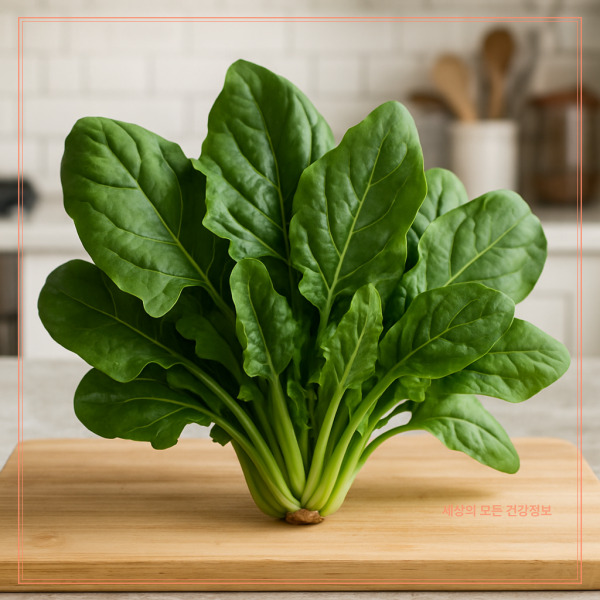
Spinach Benefits, Side Effects, Root Nutrition, and How to Wash It Properly
Spinach is packed with nutrients that offer a wide range of health benefits. However, eating too much spinach can also cause unwanted side effects. In this post, we’ll explore everything you need to know about spinach — its health benefits, potential risks, the nutritional value of spinach roots, and how to clean it thoroughly before eating.
🔰 Table of Contents 🔰
1. What Makes Spinach So Nutritious?
2. Health Benefits of Spinach
3. Why You Shouldn’t Throw Away the Roots
4. Possible Side Effects of Spinach
5. How to Properly Wash Spinach and Its Roots
6. Best Way to Store Washed Spinach
7. [Final Thoughts]
What Makes Spinach So Nutritious?
Spinach is a leafy green loaded with essential vitamins and minerals. It contains high amounts of vitamins A, C, and K, folate, iron, calcium, magnesium, and potassium. These nutrients work together to support multiple body functions, from bone strength to immune defense.

Health Benefits of Spinach
Eye Health
Spinach is rich in lutein and zeaxanthin — two powerful antioxidants that protect your eyes from harmful UV rays and reduce the risk of age-related macular degeneration.
Boosts Immunity
Thanks to its high vitamin C and antioxidant content, spinach helps strengthen your immune system and protect cells from oxidative stress.
Heart Health
The vitamin C and beta-carotene in spinach help reduce inflammation and oxidative damage, both of which are linked to heart disease. Its high potassium level also helps manage blood pressure.
Stronger Bones
Spinach provides vitamin K, calcium, and magnesium — all essential for bone formation and maintaining bone density.
Brain Function
Nutrients like vitamin C, vitamin E, and folate contribute to cognitive function and may help prevent age-related memory decline.
Blood Sugar Control
Spinach contains fiber and magnesium, which can help regulate blood sugar levels, especially important for people managing diabetes or insulin resistance.
Weight Management
Low in calories but high in fiber, spinach helps you feel full for longer, making it a great addition to any weight-loss diet.
Anti-Inflammatory Properties
Flavonoids and carotenoids in spinach can help lower chronic inflammation, which is linked to many health conditions.
Healthy Skin and Hair
The vitamins A and C in spinach support skin renewal and collagen production, helping maintain healthy skin and hair.
Improved Digestion
Spinach is rich in dietary fiber, which aids digestion and promotes regular bowel movements.

Why You Shouldn’t Throw Away the Roots
Many people discard spinach roots while cooking, but they’re actually highly nutritious. Spinach roots contain copper, manganese, anthocyanins, and trace minerals that support bone health and help reduce inflammation. Instead of cutting them off, wash them thoroughly and enjoy them along with the leaves.
Possible Side Effects of Spinach
High Oxalate Content
Spinach contains oxalates, which can contribute to kidney stone formation in people who are prone to them. If you’ve had kidney stones before, it’s best to limit your spinach intake.
Allergic Reactions
Although rare, some people may be allergic to spinach. Symptoms can include itching, hives, swelling, or even difficulty breathing.
Interaction with Blood Thinners
Spinach is rich in vitamin K, which plays a role in blood clotting. If you're taking blood-thinning medications like warfarin, consult your doctor before making major changes to your spinach consumption.
Contamination Risk
Like many leafy greens, spinach can be contaminated with bacteria like E. coli or Salmonella. Always wash it thoroughly before eating.
How to Properly Wash Spinach and Its Roots
Spinach can carry a lot of dirt, especially around the roots. Here's how to clean it properly:
Step 1: Don’t Toss the Roots
Keep the roots — they’re full of nutrients. Rinse them under running water to remove soil and grit.
Step 2: Rinse Each Leaf
Individually wash each spinach leaf under cold running water. Pay attention to the area between the leaves where dirt often hides.
Step 3: Soak in Cold Water
Fill a large bowl with cold water and gently shake the spinach in it. This loosens any remaining dirt or debris.
Step 4: Use a Vinegar Solution
For extra cleaning, mix a bit of vinegar into the water and soak the spinach briefly. This helps disinfect the leaves naturally.
Step 5: Rinse Again
Rinse the spinach multiple times with clean water to remove any remaining vinegar smell or residue.
Step 6: Dry Thoroughly
Place the washed spinach in a colander to drain, then use a salad spinner or pat gently with paper towels to remove excess moisture.

Best Way to Store Washed Spinach
Once your spinach is clean and dry, store it in an airtight container in the refrigerator. This will help keep it fresh for longer. You can take out just the amount you need and leave the rest sealed for later use.
[Final Thoughts]
Spinach is a powerhouse of nutrients and offers a wide range of health benefits — from protecting your eyes to supporting your bones and heart. However, moderation is key, especially if you have kidney issues or are on blood thinners. Don’t forget the roots — they’re packed with nutrition too. With proper washing and storage, you can enjoy spinach safely and deliciously as part of a healthy lifestyle.
©️ All About Health – Your trusted source for health insights
'All Health Information' 카테고리의 다른 글
| Air Conditioning Sickness Symptoms, Causes, Treatments | Legionnaires' Disease (3) | 2025.06.02 |
|---|---|
| Understanding Anabolic Steroids: Effects, Mechanism, and Side Effects (0) | 2025.05.18 |
| Carrot Juice Calories, Blood Sugar Impact, Health Benefits, How to Consume It (3) | 2025.05.11 |
| Gym Stationary Bike for Weight Loss (6) | 2025.05.10 |
| Avocado Benefits & Best Ways to Store: Fridge vs Freezer (13) | 2025.05.09 |



